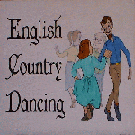User Tools
Sidebar
This is an old revision of the document!
EPSOM NEW WELLS
Longways triple minor; (Vol 2, 4th Ed. 1728).
Playford's Dancing Master of 1710,
Interpreted by Cecil Sharp in 1916
Tune: EPSOM NEW WELLS
A 1–4 M1 turns W2 RH half-way round
M1 then passes clockwise round M2
and returns to place while W2 passes
clockwise round W1 to her place.
5–8 W1 turns M2 half-way round.
W1 then passes clockwise round M1 to her place
while M2 passes clockwise round W2 to his place.
B1 1–8 M1 and W1 lead down the middle, while
M2 and W2 cast up and then follow behind them.
C1 and C2 lead through C3, cast up, men to the R
and women to their L, and return to places.
B2 1–4 M1 and M2 lead a double to the left wall,
change hands, and lead a double back to places;
while W1 and W2 lead to the right wall and back
similarly.
5–6 Partners set.
7–8 C1 cast down into second place, C2 moving up
Video: https://www.youtube.com/watch?v=tgp5wbllgEU
Most of all, The New Wells Epsom was a collection of shops and gathering venues based around a well which catered the much sought Epsom Waters and Epsom Salts to the high society of the 17th century.
The 'Medicinal Waters of Epsom' in the 17th century made it the first spa town in England, and gave rise to Epsom Salts (hydrated magnesium sulphate) as a curative. The popularity of the waters is attributed to Lord North, who in 1637 was the first to have told the English court of the use of Tonbridge and Epsom waters for health and cure, adding that it was a lot cheaper than travelling to a spa on the Continent.


